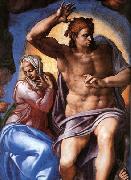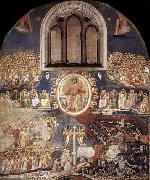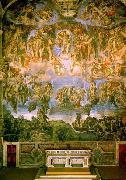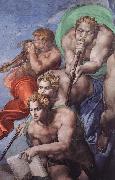
pintura al óleo, una gusto verdadero de los viejos maestros
|
Michelangelo Buonarroti
|
|||
|
|
|||
| b Caprese 1475 d Rome 1564 | |||
|
|
|||
|
|
Last Judgment new16/Michelangelo Buonarroti-747885.jpg Pintura Identificación:: 44256 |
1537-41 | |
Altura Anchura |
Pulgadas/CM |
||
|
X |
|
||
|
|
|||
|
GIOTTO di Bondone
|
|||
|
|
|||
| Italian Early Renaissance Painter, 1267-1337 | |||
|
|
|||
|
|
Last Judgment new19/GIOTTO di Bondone-337388.jpg Pintura Identificación:: 52380 |
1306 Fresco, 1000 x 840 cm | |
Altura Anchura |
Pulgadas/CM |
||
|
X |
|
||
|
|
|||
|
Michelangelo Buonarroti
|
|||
|
|
|||
| b Caprese 1475 d Rome 1564 | |||
|
|
|||
|
|
Last Judgment new21/Michelangelo Buonarroti-588655.jpg Pintura Identificación:: 62904 |
1370 x 1220 cm Cappella Sistina, Vatican This fresco was commissioned by Pope Clement VII (1523-1534) shortly before his death. His successor, Paul III Farnese (1534-1549), forced Michelangelo to a rapid execution of this work, the largest single fresco of the century. The first impression we have when faced with the Last Judgment is that of a truly universal event, at the centre of which stands the powerful figure of Christ. His raised right hand compels the figures on the lefthand side, who are trying to ascend, to be plunged down towards Charon and Minos, the Judge of the Underworld; while his left hand is drawing up the chosen people on his right in an irresistible current of strength. Together with the planets and the sun, the saints surround the Judge, confined into vast spacial orbits around Him. For this work Michelangelo did not choose one set point from which it should be viewed. The proportions of the figures and the size of the groups are determined, as in the Middle Ages, by their single absolute importance and not by their relative significance. For this reason, each figure preserves its own individuality and both the single figures arid the groups need their own background. The figures who, in the depths of the scene, are rising from their graves could well be part of the prophet Ezechiel's vision. Naked skeletons are covered with new flesh, men dead for immemorable lengths of time help each other to rise from the earth. For the representation of the place of eternal damnation, Michelangelo was clearly inspired by the lines of the Divine Comedy: Charon the demon, with eyes of glowing coal/Beckoning them, collects them all,/Smites with his oar whoever lingers. According to Vasari, the artist gave Minos, the Judge of the Souls, the semblance of the Pope's Master of Ceremonies, Biagio da Cesena, who had often complained to the Pope about the nudity of the painted figures. We know that many other figures, as well, are portraits of Michelangelo's contemporaries. The artist's self-portrait appears twice: in the flayed skin which Saint Bartholomew is carrying in his left-hand, and in the figure in the lower left hand corner, who is looking encouragingly at those rising from their graves. The artist could not have left us clearer evidence of his feeling towards life and of his highest ideals. The painting is a turning point in the history of art. Vasari predicted the phenomenal impact of the work: "This sublime painting", he wrote, "should serve as a model for our art. Divine Providence has bestowed it upon the world to show how much intelligence she can deal out to certain men on earth. The most expert draftsman trembles as he contemplates these bold outlines and marvellous foreshortenings. In the presence of this celestial work, the senses are paralysed, and one can only wonder at the works that came before and the works that shall come after". Artist: MICHELANGELO Buonarroti Title: Last Judgment Date: 1501-1550 Italian , painting : religious | |
Altura Anchura |
Pulgadas/CM |
||
|
X |
|
||
|
|
|||
|
Michelangelo Buonarroti
|
|||
|
|
|||
| b Caprese 1475 d Rome 1564 | |||
|
|
|||
|
|
Last Judgment new21/Michelangelo Buonarroti-237532.jpg Pintura Identificación:: 62913 |
1537-41 Fresco Cappella Sistina, Vatican The picture shows the Archangel St Michael with the Book of Elects. Artist: MICHELANGELO Buonarroti Title: Last Judgment (detail) Date: 1501-1550 Italian , painting : religious | |
Altura Anchura |
Pulgadas/CM |
||
|
X |
|
||
|
|
|||








